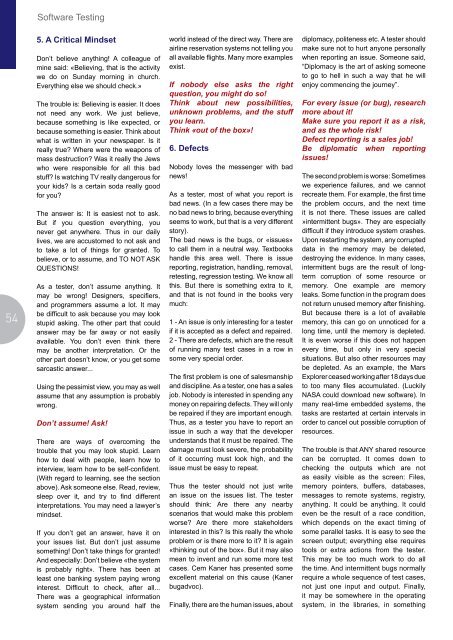Comparison of Change Management Systems
Comparison of Change Management Systems
Comparison of Change Management Systems
Create successful ePaper yourself
Turn your PDF publications into a flip-book with our unique Google optimized e-Paper software.
54<br />
S<strong>of</strong>tware Testing<br />
5. A Critical Mindset<br />
Don’t believe anything! A colleague <strong>of</strong><br />
mine said: «Believing, that is the activity<br />
we do on Sunday morning in church.<br />
Everything else we should check.»<br />
The trouble is: Believing is easier. It does<br />
not need any work. We just believe,<br />
because something is like expected, or<br />
because something is easier. Think about<br />
what is written in your newspaper. Is it<br />
really true? Where were the weapons <strong>of</strong><br />
mass destruction? Was it really the Jews<br />
who were responsible for all this bad<br />
stuff? Is watching TV really dangerous for<br />
your kids? Is a certain soda really good<br />
for you?<br />
The answer is: It is easiest not to ask.<br />
But if you question everything, you<br />
never get anywhere. Thus in our daily<br />
lives, we are accustomed to not ask and<br />
to take a lot <strong>of</strong> things for granted. To<br />
believe, or to assume, and TO NOT ASK<br />
QUESTIONS!<br />
As a tester, don’t assume anything. It<br />
may be wrong! Designers, specifiers,<br />
and programmers assume a lot. It may<br />
be difficult to ask because you may look<br />
stupid asking. The other part that could<br />
answer may be far away or not easily<br />
available. You don’t even think there<br />
may be another interpretation. Or the<br />
other part doesn’t know, or you get some<br />
sarcastic answer...<br />
Using the pessimist view, you may as well<br />
assume that any assumption is probably<br />
wrong.<br />
Don’t assume! Ask!<br />
There are ways <strong>of</strong> overcoming the<br />
trouble that you may look stupid. Learn<br />
how to deal with people, learn how to<br />
interview, learn how to be self-confident.<br />
(With regard to learning, see the section<br />
above). Ask someone else. Read, review,<br />
sleep over it, and try to find different<br />
interpretations. You may need a lawyer’s<br />
mindset.<br />
If you don’t get an answer, have it on<br />
your issues list. But don’t just assume<br />
something! Don’t take things for granted!<br />
And especially: Don’t believe «the system<br />
is probably right». There has been at<br />
least one banking system paying wrong<br />
interest. Difficult to check, after all...<br />
There was a geographical information<br />
system sending you around half the<br />
world instead <strong>of</strong> the direct way. There are<br />
airline reservation systems not telling you<br />
all available flights. Many more examples<br />
exist.<br />
If nobody else asks the right<br />
question, you might do so!<br />
Think about new possibilities,<br />
unknown problems, and the stuff<br />
you learn.<br />
Think «out <strong>of</strong> the box»!<br />
6. Defects<br />
Nobody loves the messenger with bad<br />
news!<br />
As a tester, most <strong>of</strong> what you report is<br />
bad news. (In a few cases there may be<br />
no bad news to bring, because everything<br />
seems to work, but that is a very different<br />
story).<br />
The bad news is the bugs, or «issues»<br />
to call them in a neutral way. Textbooks<br />
handle this area well. There is issue<br />
reporting, registration, handling, removal,<br />
retesting, regression testing. We know all<br />
this. But there is something extra to it,<br />
and that is not found in the books very<br />
much:<br />
1 - An issue is only interesting for a tester<br />
if it is accepted as a defect and repaired.<br />
2 - There are defects, which are the result<br />
<strong>of</strong> running many test cases in a row in<br />
some very special order.<br />
The first problem is one <strong>of</strong> salesmanship<br />
and discipline. As a tester, one has a sales<br />
job. Nobody is interested in spending any<br />
money on repairing defects. They will only<br />
be repaired if they are important enough.<br />
Thus, as a tester you have to report an<br />
issue in such a way that the developer<br />
understands that it must be repaired. The<br />
damage must look severe, the probability<br />
<strong>of</strong> it occurring must look high, and the<br />
issue must be easy to repeat.<br />
Thus the tester should not just write<br />
an issue on the issues list. The tester<br />
should think: Are there any nearby<br />
scenarios that would make this problem<br />
worse? Are there more stakeholders<br />
interested in this? Is this really the whole<br />
problem or is there more to it? It is again<br />
«thinking out <strong>of</strong> the box». But it may also<br />
mean to invent and run some more test<br />
cases. Cem Kaner has presented some<br />
excellent material on this cause (Kaner<br />
bugadvoc).<br />
Finally, there are the human issues, about<br />
diplomacy, politeness etc. A tester should<br />
make sure not to hurt anyone personally<br />
when reporting an issue. Someone said,<br />
“Diplomacy is the art <strong>of</strong> asking someone<br />
to go to hell in such a way that he will<br />
enjoy commencing the journey”.<br />
For every issue (or bug), research<br />
more about it!<br />
Make sure you report it as a risk,<br />
and as the whole risk!<br />
Defect reporting is a sales job!<br />
Be diplomatic when reporting<br />
issues!<br />
The second problem is worse: Sometimes<br />
we experience failures, and we cannot<br />
recreate them. For example, the first time<br />
the problem occurs, and the next time<br />
it is not there. These issues are called<br />
»intermittent bugs». They are especially<br />
difficult if they introduce system crashes.<br />
Upon restarting the system, any corrupted<br />
data in the memory may be deleted,<br />
destroying the evidence. In many cases,<br />
intermittent bugs are the result <strong>of</strong> longterm<br />
corruption <strong>of</strong> some resource or<br />
memory. One example are memory<br />
leaks. Some function in the program does<br />
not return unused memory after finishing.<br />
But because there is a lot <strong>of</strong> available<br />
memory, this can go on unnoticed for a<br />
long time, until the memory is depleted.<br />
It is even worse if this does not happen<br />
every time, but only in very special<br />
situations. But also other resources may<br />
be depleted. As an example, the Mars<br />
Explorer ceased working after 18 days due<br />
to too many files accumulated. (Luckily<br />
NASA could download new s<strong>of</strong>tware). In<br />
many real-time embedded systems, the<br />
tasks are restarted at certain intervals in<br />
order to cancel out possible corruption <strong>of</strong><br />
resources.<br />
The trouble is that ANY shared resource<br />
can be corrupted. It comes down to<br />
checking the outputs which are not<br />
as easily visible as the screen: Files,<br />
memory pointers, buffers, databases,<br />
messages to remote systems, registry,<br />
anything. It could be anything. It could<br />
even be the result <strong>of</strong> a race condition,<br />
which depends on the exact timing <strong>of</strong><br />
some parallel tasks. It is easy to see the<br />
screen output; everything else requires<br />
tools or extra actions from the tester.<br />
This may be too much work to do all<br />
the time. And intermittent bugs normally<br />
require a whole sequence <strong>of</strong> test cases,<br />
not just one input and output. Finally,<br />
it may be somewhere in the operating<br />
system, in the libraries, in something



